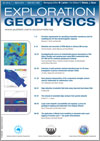
Exploration Geophysics
Volume 44 Number 1 2013
EG12040Precision requirements for specifying transmitter waveforms used for modelling the off-time electromagnetic response
When modelling EM data, it is not necessary to specify all parts of the transmitter current waveform precisely. Accurate responses can be obtained if the latter part of the waveform is specified precisely; the early part can be expressed approximately, provided the area under the waveform curve is precise.
EG12048Detection and correction of SPM effects in airborne EM surveys
The SPM decay can be approximated as a decay proportional to time to the inverse power. We use this approximation with least-squares fitting to distinguish SPM effects from the response of a conductor. Application shows that it aids significantly in conductive target identification.
EG12006Investigating the source of contaminated plumes downstream of the Alborz Sharghi coal washing plant using EM34 conductivity data, VLF-EM and DC-resistivity geophysical methods
EM34, VLF and DC-resistivity methods have been effectively used to investigate the environmental impact of a coal waste pile at the Alborz Sharghi coal washing plant, north-east Iran. Two-dimensional resistivity sections and quasi-three-dimensional models obtained by the inversion of EM34 conductivity data together with the results of VLF and DC-resistivity methods have identified conductive leachate plumes downstream of the waste pile and decreasing resistivity at deeper levels of the earth due to the migration of contaminated plumes.
EG12002Extension of split perfectly matched absorbing layer for 2D wave propagation in porous transversely isotropic media
In this paper, the split perfectly matched absorbing layer is extended to fluid-saturated porous anisotropic media based on Biot’s equations and the staggered-grid finite-difference method. The results from homogeneous and heterogeneous models show that the algorithm is stable and efficient for modelling in these media.
EG12073Rock physical interpretation of the compressive strength–seismic velocity relationship for sedimentary rocks
The confined compressive strength–seismic velocity relationship is modelled by combining two effective-medium models for the confined compressive strength versus porosity and seismic velocity versus porosity. The model is verified through its application to actual seismic P- and S-wave velocities and confined compressive strength data of sedimentary rocks.
EG12022Edge detection of potential field data using improved local phase filter
A new edge detection filter to delineate the edges of the source automatically, called the improved local phase (ILP) filter, is presented. The ILP filter is formed by the first- and second-order horizontal derivatives, so it is computationally stable.
This paper compares three methods which remove unwanted edge contours from gravity datasets. The first method removes edges which are not present in the data after its upward continuation to a given height, the second method removes edges whose amplitude is below a given threshold, while the final method removes the shortest edge contours.
EG12019Large scale magnetic susceptibility soil mapping: a proxy for geological mapping and exploration from Bogoso (Ghana)
This paper describes the use of magnetic susceptibility measurements on soil samples. In the deeply weathered lateritic context of the study area, soil magnetic susceptibility reveals similarities with magnetic/geochemical survey results, suggesting this rapid and easy to use technique can be an effective tool for exploration and geological programs.
EG12018The application of Monte Carlo modelling to downhole total-count logging of uranium: part I – low grade mineralisation
A novel approach is proposed for estimating uranium grades from gamma-ray probes, which is demonstrated for the Angela deposit. Gamma-ray transport modelling of the unique probe response (including energy threshold) is allied with the response from model pits to correct for casing, water, borehole diameter, dead-time and the Z-effect.

